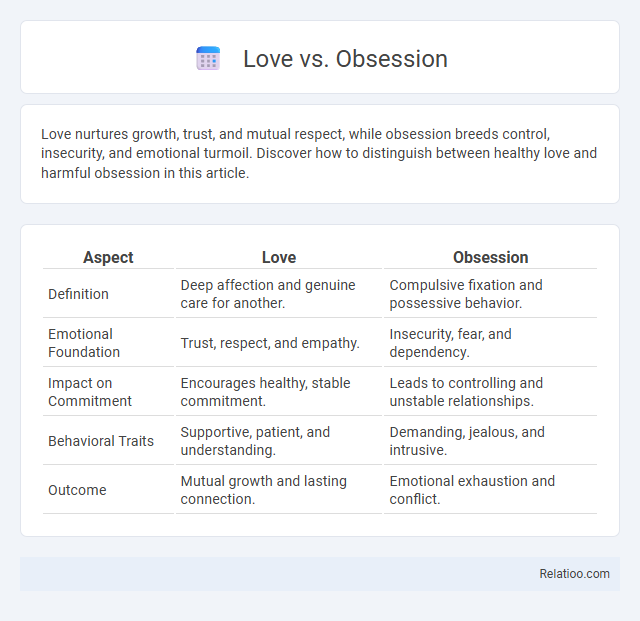Love nurtures growth, trust, and mutual respect, while obsession breeds control, insecurity, and emotional turmoil. Discover how to distinguish between healthy love and harmful obsession in this article.
Table of Comparison
| Aspect | Love | Obsession |
|---|---|---|
| Definition | Deep affection and genuine care for another. | Compulsive fixation and possessive behavior. |
| Emotional Foundation | Trust, respect, and empathy. | Insecurity, fear, and dependency. |
| Impact on Commitment | Encourages healthy, stable commitment. | Leads to controlling and unstable relationships. |
| Behavioral Traits | Supportive, patient, and understanding. | Demanding, jealous, and intrusive. |
| Outcome | Mutual growth and lasting connection. | Emotional exhaustion and conflict. |
Defining Love and Obsession
Love is a deep emotional connection characterized by trust, respect, and selflessness, fostering mutual growth and well-being between individuals. Obsession, in contrast, involves an overwhelming fixation marked by possessiveness, insecurity, and a lack of boundaries, often leading to emotional distress and control issues. Defining love requires understanding its foundation in genuine care and balance, while obsession reflects unhealthy attachment and dependency.
Key Differences Between Love and Obsession
Love involves genuine care, mutual respect, and emotional support, fostering healthy relationships based on trust and understanding. Obsession is characterized by excessive fixation, possessiveness, and a lack of boundaries, often leading to anxiety and unhealthy behavior. Key differences include emotional balance in love versus emotional dependency in obsession, and respect for individuality in love compared to control and manipulation in obsession.
Signs of Healthy Love
Signs of healthy love include mutual respect, open communication, and emotional support that fosters growth and trust between partners. Unlike obsession, healthy love allows personal boundaries and independence, promoting a balanced and fulfilling relationship. Consistent empathy and shared values further distinguish genuine love from unhealthy attachment or fixation.
Warning Signals of Obsession
Recognizing the warning signals of obsession is crucial for maintaining healthy relationships and distinguishing them from genuine love. Obsession often manifests as excessive control, constant need for reassurance, and intrusive behaviors that violate personal boundaries. Your awareness of these red flags helps protect emotional well-being and fosters balanced, respectful connections.
Emotional Impact on Relationships
Love fosters deep emotional connection and trust, promoting healthy, supportive relationships where individuals feel valued and secure. Obsession, characterized by intense fixation and possessiveness, often leads to emotional turmoil and imbalance, undermining relationship stability and mutual respect. Distinguishing genuine love from obsession is crucial for maintaining emotional well-being and long-term relationship success.
Psychological Roots of Obsession
Obsession stems from unmet attachment needs and deep-seated insecurities that distort genuine affection into compulsive fixation, often hijacking emotional regulation centers in the brain such as the amygdala. In contrast, healthy love is characterized by mutual respect, emotional balance, and secure attachment patterns, supported by the prefrontal cortex's role in impulse control and empathy. Understanding the neuropsychological underpinnings of obsession reveals its association with heightened dopamine activity and disrupted oxytocin signaling, which differentiates it fundamentally from authentic love experiences.
How Love Fosters Growth
Love fosters growth by nurturing emotional security and encouraging personal development within relationships. Unlike obsession, which is characterized by control and fixation, love promotes mutual respect and supports each person's aspirations. When you experience genuine love, it creates a foundation for trust and empowers positive change.
Consequences of Obsessive Attachment
Obsessive attachment in relationships often results in emotional imbalance, leading to anxiety, jealousy, and a loss of personal identity. Unlike healthy love, which fosters mutual respect and growth, obsession generates controlling behaviors and emotional dependency, causing long-term psychological distress. The consequences frequently include strained relationships, diminished self-esteem, and an increased risk of mental health issues such as depression and anxiety disorders.
Steps to Transition from Obsession to Healthy Love
Recognizing obsession involves acknowledging intense, intrusive thoughts and compulsive behaviors centered on one person, which can hinder emotional well-being. Steps to transition from obsession to healthy love include developing self-awareness, setting personal boundaries, and fostering mutual respect and trust through open communication. Engaging in self-care practices and seeking professional support when needed further promotes emotional balance and genuine connection.
Building Lasting, Balanced Relationships
Building lasting, balanced relationships requires distinguishing love from obsession by fostering trust, respect, and open communication. Your emotional well-being thrives when you prioritize genuine connection over possessiveness or control, creating a foundation for mutual growth. Recognizing the difference empowers you to nurture relationships that endure through challenges and time.

Infographic: Love vs Obsession
 relatioo.com
relatioo.com